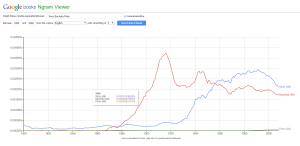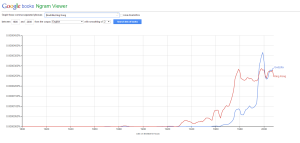For the NGram project, I figured I’d geek out a little and check out how the English corpus treated two different topics- one serious, one not so much.
First, I opted to get serious- namely, the occurrence of the words, “virus”, “bacteria”, and “prion”, in literature, from 1800 to 2008.

Viruses are seen in blue, bacteria in red, and prions in green. For those who don’t know the difference, here’s a simple rundown:
- Bacteria are your standard, run of the mill organisms: simple, single celled creatures, who exist to consume and reproduce. They cause disease in a wide variety of ways, but, generally, from either attacking body tissue, or (more often) as a byproduct of immune response. Antibiotics exist and are used to destroy them by preventing the microbes from reproducing (and letting your immune system do the dirty work), or by outright killing them. Due to the rapid reproductive rate of bacteria, mutations in a short span of time can make these robust organisms immune to antibiotics in subsequent generations- hence, the need to lower the selection pressure we’re putting on them and tone down our (often unnecessary) use of antibiotics. Famous examples: Yersinia pestis (the Black Plague), Salmonella, Staphylococcus.
- Somewhere in between bacteria and prions, you find viruses. Viruses are simple: DNA or RNA encapsulated by a protein structure. They get in you, hijack your cells, use them to reproduce…and don’t stop doing so. Illness is caused much like a bacteria- either by the destruction of your cells, or the immune response of the human body (fevers, inflammation). I say viruses fall in between bacteria and prions because the debate as to whether they’re truly living organisms is very much still ongoing. They fit all the characteristics (reproduce, a need to feed [of sorts], require shelter), but the sheer alien nature of their existence sets them apart from something like bacteria, which is fairly familiar (reproduces independently of a host, is comprised of organelles, needs to actively eat something to survive). No real treatments exist for viral infections, though antiviral medication does exist and is used in cases of certain diseases, such as HIV. Luckily, viruses are very vulnerable to vaccination, and prevention is possible for many viral diseases. Famous examples: Smallpox, Ebola, Influenza, the common cold, HIV.
- Prions are a somewhat newfound disease, and, if the sliding scale goes from bacteria (living) to virus (uncertain), then prions comprise the final extreme. Prions are, simply, malformed proteins. They are not necessarily “malicious”like bacteria and viruses, which actively seek to spread, but are simply proteins that are stable, and, when assimilated by the body, scramble the reproductive codes for cells. When a prion enters the body, it is assimilated by the relevant tissues and replaces the previous proteins in its place. When this occurs, the cells left over attempt to reproduce this protein instead, and does so- from there on, a wildfire of exponential growth occurs and the protein floods the tissue, destroying it and causing severe, incurable and 100% terminal illness. Due to their stability, prions are very hard to deal with and require incredibly vigorous, extraordinary methods of cleaning to destroy them- unlike viruses and bacteria, they do not simply “die”. Famous examples: Mad Cow Disease, Kuru
The graph produced was fairly informative, and very surprising! Mostly, I was completely astounded that the word “virus” was actually used fairly often, even before the first confirmation of the entity itself was known. I am told by Google that the word had a previous medical application, meaning “slimy, liquid poison”, often originating from the body of a sickly person- and something that could spread to others. When discovered in 1892 by Martinus Beijerinck, who coined the term, I suppose that seemed like the most apt description of the contagion (and, I believe, it still is). A massive uptick in references to the word “virus” occur in about 1935, four years after the electron microscope first allowed us to physically see the entities that perplexed Pasteur and his ilk (Pasteur, who pioneered vaccination, could find no microorganism responsible for rabies- only symptoms). Since then, as microbiology, imaging, and a variety of health sciences advanced, a massive increase in usage of the phrase continued through to the 21st century- though, a decrease in usage is noted towards the 1990s.
Bacteria, having been discovered and confirmed much earlier, is unsurprisingly much more popular in usage from an earlier point. A massive uptick in usage is documented between 1910, and 1930- possibly due to battlefield injuries from the first World War, as well as advances in microbiology. Usage increases again in 1940 (again coinciding with another World War), possibly due to the beginning of the usage of commercially available antibiotics. Usage of the word has decreased ever since, presumably since treatment is so effective (who wants to write a fiction book about a bacterial plague, when we can easily cure one?) and discovery of new bacterial forms is no longer revolutionary, as it once was.
Prions have not yet seen their day of popularity (and, I hope, never will)- since Prion theory is very new (dating back to 1962, at the earliest), and only a handful of known diseases are caused by prions (and those require very special facilities to be worked on in a lab), I imagine not much literature would cover the topic. Interestingly, usage increases in the mid-nineties- coinciding with the release of Michael Crichton’s Jurassic Park and The Lost World- the former which mentioned prions, and the latter which used them centrally as a plot point.
Aside from disease, I opted to also take a look at something a little less serious- giant monsters.

Unsurprisingly, both movies feature heavy popularity and consistent mentions after their initial releases. Peaks exist, coinciding with major sequel releases- most notably, the 1976 remake of King Kong, and the 1998 American version of Godzilla. Surprisingly, the peak for Peter Jackson’s 2005’s remake of King Kong is fairly small. I would be very interested to see how it peaks after closer to 2014, with another American remake of Godzilla.
Incidentally, I find it very interesting that King Kong actually lags behind popular mentions in the English language- an American monster movie that existed for much longer prior to Godzilla, somehow finds much less staying power (in terms of popularity) than its Japanese counterpart.